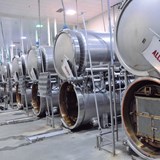Retorts have an internal environment of high temperatures and pressures created by steam, water and oxygen. When excessive harmful chloride ions are present inside, the ions act as a catalyst for starting and accelerating corrosion in stainless steel during the retort cycle. Unless steps are taken to identify, reduce, or eliminate the causes of corrosion, the retorts may have their service lives cut short. Jeff Arthur now explains how corrosion happens in these retorts and gives recommendations on how to spot and reduce the risk of decreased service life.
To read the full Stainless Steel World Americas February 2020 tech talk, please contact Brittani Schroeder (b.schroeder@kci-world.com) for the PDF version.

